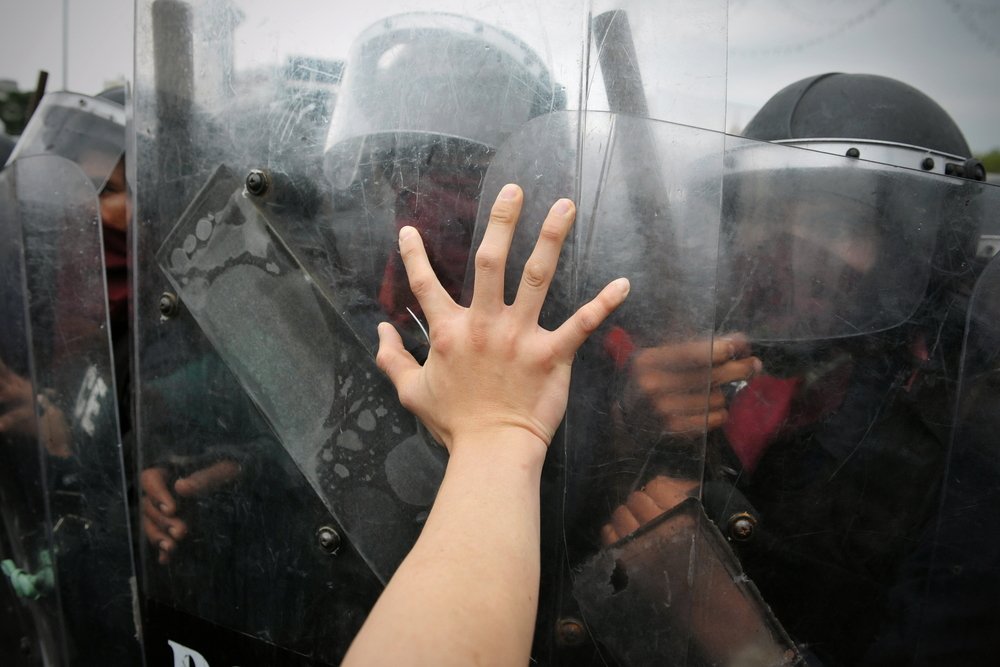Penal Code 243c2 PC makes it a crime to commit battery on a peace officer in California. This is defined as willfully and unlawfully touching a peace officer in an offensive manner. A conviction can lead to a felony charge punishable by up to three years in jail or prison.
The language of the code section states that:
(c) (2). When the battery specified in paragraph (1) is committed against a peace officer engaged in the performance of his or her duties, whether on or off duty, including when the peace officer is in a police uniform and is concurrently performing the duties required of him or her as a peace officer while also employed in a private capacity as a part-time or casual private security guard or patrolman and the person committing the offense knows or reasonably should know that the victim is a peace officer engaged in the performance of his or her duties, the battery is punishable by a fine of not more than ten thousand dollars ($10,000), or by imprisonment in a county jail not exceeding one year or pursuant to subdivision (h) of Section 1170 for 16 months, or two or three years, or by both that fine and imprisonment.
Examples
- kicking a police officer while resisting arrest.
- throwing a frozen bottle of water at a sheriff during a protest.
- pushing a prosecutor during the course of a criminal trial.
Defenses
People accused of a crime under this statute can challenge the accusation with a legal defense. A few common defenses include defendants showing that they:
- acted in self-defense,
- did not willfully touch an officer, and/or
- did not know that the “victim” was a peace officer.
Penalties
A violation of California Penal Code Section 243c2 is a wobbler offense. A wobbler is a crime that a prosecutor can charge as either a misdemeanor or a felony.
Misdemeanor battery on a peace officer is punishable by custody in a county jail for up to one year.
Felony battery is punishable by a jail or prison term of up to three years.
Our California criminal defense attorneys will discuss the following in this article:
- 1. How does California law define “battery on a peace officer”?
- 2. Are there legal defenses to PC 243c2 charges?
- 3. What are the penalties?
- 4. Are there related offenses?

Penal Code 243c2 PC makes it illegal to willfully and unlawfully touch a peace officer in an offensive manner.
1. How does California law define “battery on a peace officer”?
A prosecutor must prove the following to successfully convict a person of committing a simple battery on a peace officer:
- the alleged victim was a peace officer performing his/her official duties,
- the defendant willfully and unlawfully touched the victim in a harmful or offensive manner, and
- when the defendant acted, he/she knew, or reasonably should have known, that the victim was a peace officer engaged in the performance of his/her duties.1
Under California law, a “peace officer” is essentially a person who works to help enforce the law. Common examples include:
- police officers,
- law enforcement personnel,
- sheriffs,
- the Attorney General, and
- prosecutors.2
Note that a defendant does not have to cause some type of physical injury to be guilty of the crime of battery. The focus is on any offensive touching or contact.
Further, the slightest physical contact can be enough to commit a battery if it is done in a rude or angry way. Making contact with another person, including through his or her clothing, is enough.3
The touching can also be done indirectly. Indirectly means that a person causes an object or someone else to touch the peace officer.4
2. Are there legal defenses to PC 243c2 charges?
Criminal defense lawyers draw upon several legal strategies to help clients contest criminal charges pursuant to California Penal Code 243c2. Three common ones include showing that accused people:
- acted in self-defense,
- did not act willfully.
- had no knowledge that a “victim” was a peace officer.
2.1 Self-defense
Defendants can always contest a battery on a peace officer allegation by showing that they acted in self-defense.5 Perhaps, for example, the accused was trying to fight off an instance of police misconduct or brutality.
2.2 No willful act
Recall that people are only guilty under this statute if they acted willfully. Therefore, an accused can raise the defense that there is reasonable doubt as to whether he/she acted on purpose. Perhaps, for example, the defendant touched a peace officer on accident.
2.3 No knowledge of a peace officer
Recall, too, that defendants are only guilty of violating this law if they knew that the “victim” was a peace officer. Therefore, an accused can challenge a charge by showing that he/she did not have this knowledge.

Violations of Penal Code 243c2 PC can result in jail time and/or fines.
3. What are the penalties?
A violation of this law is a wobbler. A prosecutor can charge a wobbler as either a misdemeanor or a felony.
Misdemeanor battery is punishable by:
- custody in county jail for up to one year, and/or
- a maximum fine of $10,000.6
Felony battery is punishable by:
- custody in state prison for up to three years, and/or
- a maximum fine of $10,000.7
With regards to felony battery, a judge can impose additional prison time if a defendant committed a battery and it resulted in great bodily injury or serious bodily injury to the peace officer.
This sentencing enhancement can result in an additional 6 years to a person’s battery sentence.
4. Are there related offenses?
There are three crimes related to battery on a peace officer. These include:
- battery against a protected person – PC 243c1,
- resisting an executive officer – PC 69, and
- resisting arrest – PC 148.
4.1 Battery against a protected person – PC 243c1
Per Penal Code 243c1 PC, battery against a protected person is the crime where a person willfully and unlawfully touches a “protected person” in an offensive manner.
A “protected person” is a person that carries a title that is specifically mentioned in the language of PC 243c1. Examples include:
- custodial officers,
- emergency medical technicians (EMTs),
- lifeguards,
- animal control officers,
- process servers, and
- traffic officers.
Note that with both PC 243c2 and PC 243c1, a defendant can face additional charges if he/she assaults a peace officer or protected person with a deadly weapon. This is a separate crime per Penal Code 245a1.
4.2 Resisting an executive officer – PC 69
Per Penal Code 69 PC, resisting an executive officer is the crime where people use threats or violence to prevent executive officers from performing their duties, or resist executive officers in the performance of their duties.
Unlike with PC 243c2, this statute specifically applies to executive officers. An “executive officer” is defined as a government official who may use his own discretion in performing his duties.8 Examples include:
- police officers and sheriffs,
- judges,
- government prosecutors and defense attorneys, and
- other elected officials.
4.3 Resisting arrest – PC 148
Under Penal Code 148 PC, resisting arrest is the crime where people willfully resist, delay, or obstruct law enforcement officers or emergency medical technicians in the performance of their official duties.
Unlike with PC 243c2, a violation of this law is always charged as a misdemeanor, punishable by up to one year in county jail.
For additional help…

Contact us for help
For additional guidance or to discuss your case with a criminal defense lawyer, we invite you to contact our law firm at the Shouse Law Group. Our attorneys provide both free consultations and legal advice you can trust.
Our attorneys also represent clients throughout California, including those in Los Angeles, San Diego, and Orange County.
Legal References:
- CALCRIM No. 945 – Battery Against a Peace Officer. Judicial Council of California Criminal Jury Instructions (2020 edition). As to an officer being engaged in his/her official duties, see People v. Pennington (2014) 229 Cal.App.4th 1376.
- California Penal Code 830.1 PC.
- CALCRIM No. 945. See also In re B.L. (2015) 239 Cal.App.4th 1491; and, People v. Myers (1998) 61 Cal.App.4th 328.
- CALCRIM No. 945. See also In re B.L., supra.
- CALCRIM No. 945.
- California Penal Code 243(c)(2) PC.
- See same.
- CALCRIM No. 2652 – Resisting an Executive Officer in Performance of Duty.
